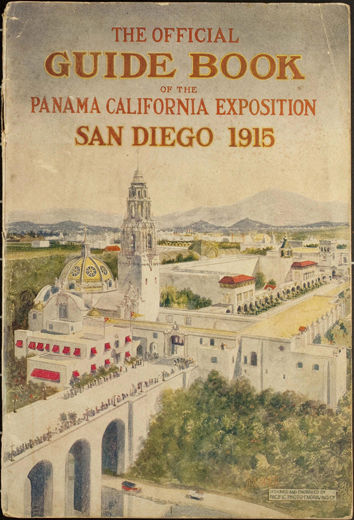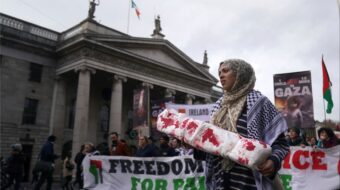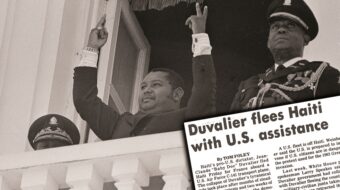
One hundred years ago, on July 27, 1915, former president Theodore Roosevelt visited the Panama-California Exposition in San Diego, and said, in front of the Spreckels Organ Pavilion, “It is so beautiful that I wish to make an earnest plea… I hope that not only will you keep these buildings running for another year but you will keep these buildings of rare, phenomenal taste and beauty permanently.”
The Exposition featuring art, industry, and pavilions from several states and nations, remained open between Jan. 1, 1915, and Jan. 1, 1917. It celebrated the opening of the Panama Canal, an immense engineering feat, built at enormous material and human cost, which dramatically cut the distance and cost of international shipping. The expo was meant to tout San Diego as the first U.S. port of call for ships traveling north after passing westward through the canal. The fair was held inside the 1400 acres of San Diego’s large urban Balboa Park.
At the time the exposition was planned, the city had fewer than 40,000 inhabitants, and just over 60,000 in all of San Diego County. By contrast, Los Angeles had over 300,000, and San Francisco over 400,000. For a city of San Diego’s size, it was a bold stretch to attempt mounting an international expo, but the plan worked, and the port city grew exponentially in succeeding years.
San Diego’s Chamber of Commerce and leading business figures recognized their strategic location and wanted to take advantage of it. In order to attract future settlers, the military, and investors, they decided on an exposition to help market and develop San Diego as an urban center with the resources to handle the new maritime traffic coming in from the canal while maintaining its small town charm.
Two big obstacles
Exposition planners confronted several obstacles, however. The ten-year-long Mexican Revolution (1910-1920) had San Diego’s immediate neighbor to the south in turmoil. Anarchists and other radicals flowed back and forth between the two countries, and were tied to activists in the Industrial Workers of the World (IWW) in the U.S. San Diego could not afford to allow radicals to disrupt its labor force, flood the streets with inflammatory speakers of questionable “moral” character, and challenge the commercial viability of the Exposition.
Those years, beginning with the expo groundbreaking in 1911, were both repressive and exhilarating. A law directed against radicalism was passed, and resistance quickly arose. A chapter of the California Free Speech League, comprising 2,500 San Diegans of various political persuasions, opposed to the ordinance, retained attorney E. E. Kirk, a well known San Diego socialist, to represent the IWW. San Diego became famous in labor history for its free speech martyrs, and ultimate success in defending the First Amendment.
Another issue for the Exposition planners was its ideological orientation. The decades following the Cuban-Spanish-American War, which yielded the Philippines and Puerto Rico as U.S. colonies, represent the highpoint in American imperialism. Somehow the Exposition had to reflect the hegemony of advanced, progressive, white Northern European civilization as the natural, rightful successor to millennia of Native culture and also to the centuries-long rule of Spain, Mexico, and the Californios, the Hispanic upper class.
San Diego’s boosters marketed their expo on a vacuous Spanish history inspired by Helen Hunt Jackson’s popular novel “Ramona.” In order to successfully market the expo to an Anglo demographic, the Spanish history and the earlier Native history had to be romanticized, whitewashing away all conflict, controversy, and racism into a nostalgic haze.
About 300 Indians from Apache, Navajo, Supai, Tewa, and Tiwa tribes resided in replicas of tepees, mounds or pueblos, built by the Santa Fe Railway, near the north gate. The Indians wove rugs and blankets, shaped pottery, pounded silver and copper into jewelry and ornaments, performed ceremonial dances, and offered prayers to their gods. The emphasis was on the quaint and picturesque, much like the Indian head pennies and buffalo nickels of the period.
Exhibitions showed modern manufacturing devices and scientific displays in operation, and the park had a real citrus orchard. Extensive gardens on the grounds showed that the southwest quartile of the United States could be made to flourish and bloom with modern ingenuity.
Bertram Goodhue designed the buildings, creating a new architectural style that combined Mediterranean, Italian and Spanish motifs. The result was a wildly ornate style, called “churrigueresque,” that took Pueblo Revival and Mission Revival to new levels of exuberance.
The fair left a permanent mark in San Diego. The original buildings have remained in Balboa Park and are now major cultural centers and museums. The expo also led to the eventual establishment of the San Diego Zoo, which grew out of abandoned exotic animal exhibitions from the Central American Isthmus portion of the expo.
Today San Diego is the eighth-largest city in the U.S., and owes much of its growth to the Panama-California Exposition of a century ago.
Sources include: csusm.org, sandiegohistory.org Wikipedia and others. Sohosandiego.org lists Photo: Guide Book of the Panama California Exposition. Licensed under Public Domain via Wikimedia Commons.












Comments